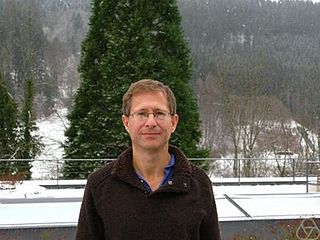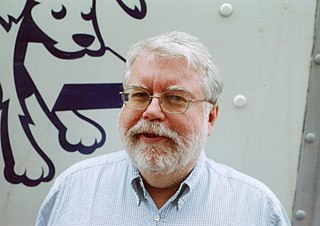In mathematical logic, a theory is categorical if it has exactly one model. Such a theory can be viewed as defining its model, uniquely characterizing the model's structure.

Yonatan Ratosh was the literary pseudonym of Uriel Shelach, an Israeli poet and journalist who founded the Canaanite movement.

Ehud Hrushovski is a mathematical logician. He is a Merton Professor of Mathematical Logic at the University of Oxford and a Fellow of Merton College, Oxford. He was also Professor of Mathematics at the Hebrew University of Jerusalem.

Rami Grossberg is a full professor of mathematics at Carnegie Mellon University and works in model theory.

Leo Anthony Harrington is a professor of mathematics at the University of California, Berkeley who works in recursion theory, model theory, and set theory. Having retired from being a Mathematician, Professor Leo Harrington is now a Philosopher.
In the mathematical field of set theory, the proper forcing axiom (PFA) is a significant strengthening of Martin's axiom, where forcings with the countable chain condition (ccc) are replaced by proper forcings.
In the mathematical field of model theory, a theory is called stable if it satisfies certain combinatorial restrictions on its complexity. Stable theories are rooted in the proof of Morley's categoricity theorem and were extensively studied as part of Saharon Shelah's classification theory, which showed a dichotomy that either the models of a theory admit a nice classification or the models are too numerous to have any hope of a reasonable classification. A first step of this program was showing that if a theory is not stable then its models are too numerous to classify.
In model theory, a forking extension of a type is an extension of that type that is not free whereas a non-forking extension is an extension that is as free as possible. This can be used to extend the notions of linear or algebraic independence to stable theories. These concepts were introduced by S. Shelah.

Menachem Magidor is an Israeli mathematician who specializes in mathematical logic, in particular set theory. He served as president of the Hebrew University of Jerusalem, was president of the Association for Symbolic Logic from 1996 to 1998 and as president of the Division for Logic, Methodology and Philosophy of Science and Technology of the International Union for History and Philosophy of Science (DLMPST/IUHPS) from 2016 to 2019. In 2016 he was elected an honorary foreign member of the American Academy of Arts and Sciences. In 2018 he received the Solomon Bublick Award.
Michael Makkai is a Canadian mathematician of Hungarian origin, specializing in mathematical logic. He works in model theory, category theory, algebraic logic, type theory and the theory of topoi.
In the mathematical field of set theory, the Solovay model is a model constructed by Robert M. Solovay in which all of the axioms of Zermelo–Fraenkel set theory (ZF) hold, exclusive of the axiom of choice, but in which all sets of real numbers are Lebesgue measurable. The construction relies on the existence of an inaccessible cardinal.
Moti Gitik is a mathematician, working in set theory, who is professor at the Tel-Aviv University. He was an invited speaker at the 2002 International Congresses of Mathematicians, and became a fellow of the American Mathematical Society in 2012.
In model theory, a discipline within mathematical logic, an abstract elementary class, or AEC for short, is a class of models with a partial order similar to the relation of an elementary substructure of an elementary class in first-order model theory. They were introduced by Saharon Shelah.
In mathematics, iterated forcing is a method for constructing models of set theory by repeating Cohen's forcing method a transfinite number of times. Iterated forcing was introduced by Solovay and Tennenbaum in their construction of a model of set theory with no Suslin tree. They also showed that iterated forcing can construct models where Martin's axiom holds and the continuum is any given regular cardinal.
In model theory, a discipline within the field of mathematical logic, a tame abstract elementary class is an abstract elementary class (AEC) which satisfies a locality property for types called tameness. Even though it appears implicitly in earlier work of Shelah, tameness as a property of AEC was first isolated by Grossberg and VanDieren, who observed that tame AECs were much easier to handle than general AECs.
In mathematical set theory, the Sacks property holds between two models of Zermelo–Fraenkel set theory if they are not "too dissimilar" in the following sense.
Maryanthe Elizabeth Malliaris is a professor of mathematics at the University of Chicago, a specialist in model theory.

Martin Goldstern is an Austrian mathematician and university professor for set theory at the TU Wien and head of the research unit 8 of the Institute of Discrete Mathematics and Geometry. His main research lies in set theory of the real line and forcing theory, and applications of set theory in universal algebra.






